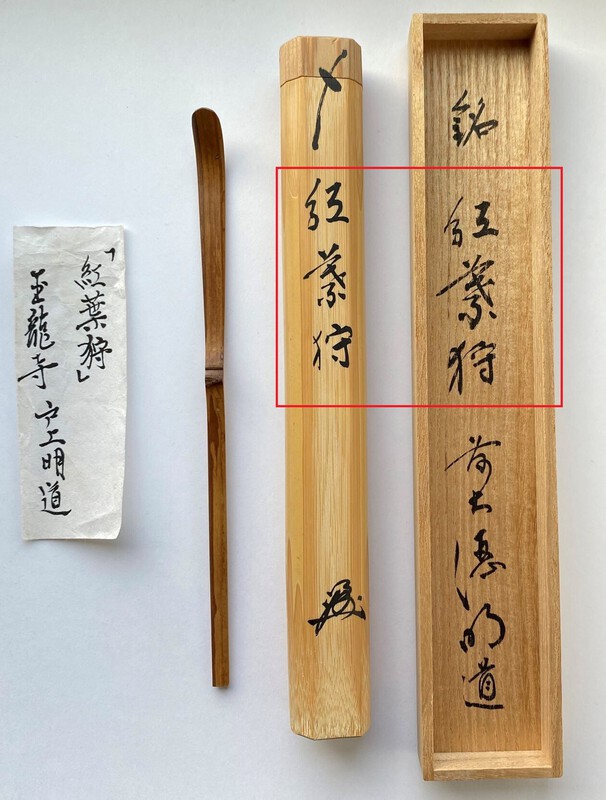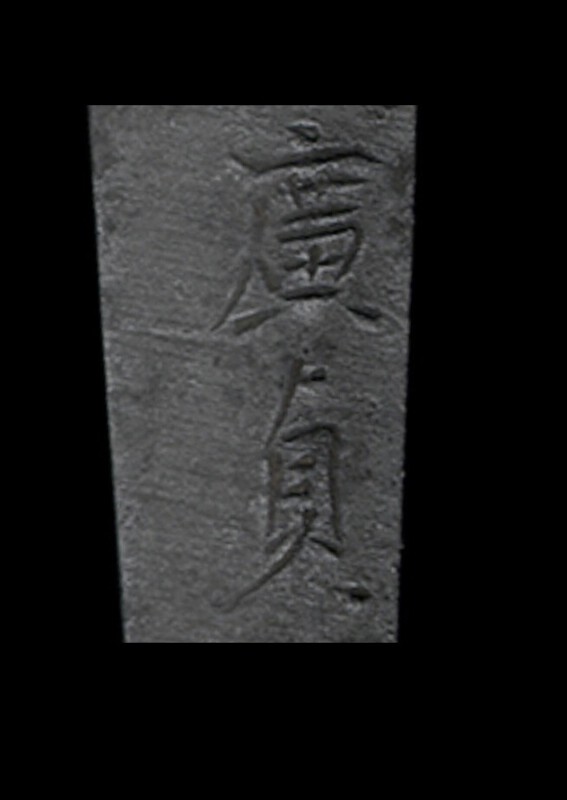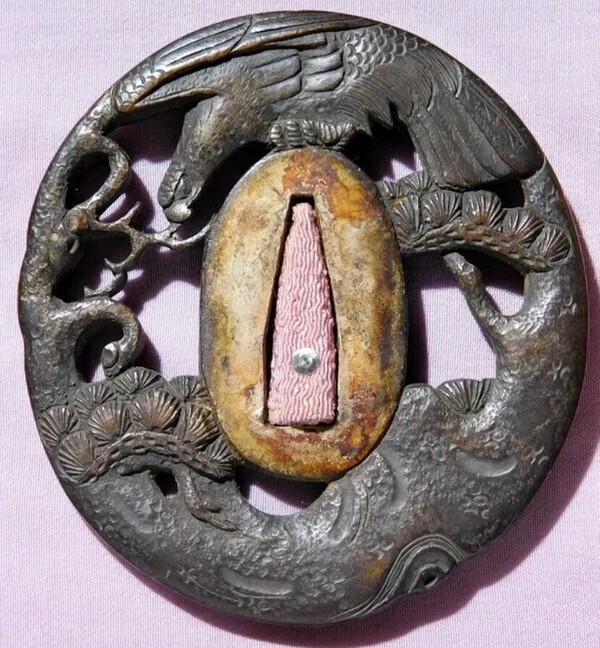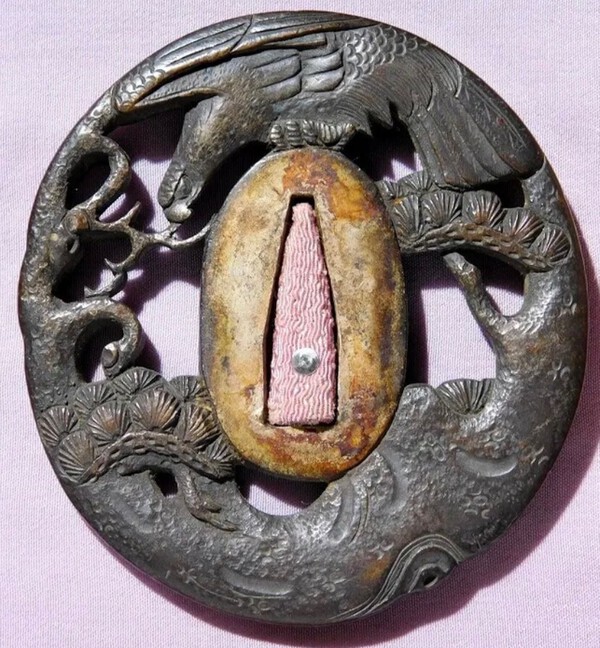-
Posts
1,919 -
Joined
-
Last visited
-
Days Won
5
Content Type
Profiles
Forums
Events
Store
Downloads
Gallery
Everything posted by Mark S.
-
For all the discussion of gimei based on a stroke here or there, two really great photos of both these mei side by side would be enlightening. Both signed by the same hand on same day… identical? Just for discussion sake…
-
So Momijikari = “red leaves hunting” or "autumn leaf hunting” - to admire the beautiful autumn leaves
-
Thank you so much.
-
Steve… thank you so much. I always try with nihonto related items, but without any working knowledge of written Japanese, I rely on the kindness of members.
-
I am sorry to impose, but would someone be able to help me with this chashaku’s mei or poetic name (highlighted in red)? If you wish to add any of the other information, I would be grateful but don’t want to over-extend my request. I believe the chashaku was ‘named’ by Myodo Togami (not sure who actually made the scoop) who is Chief Priest at Gyokuryuji Temple. I believe the last two characters on the inside of the box are “Myodo”? Thank You
-
A tsuba I just picked up… slightly different and probably a simpler design. Just thought it might be of interest.
-
If I’m not mistaken, Unryu translates to “cloud dragon”.
-
Now you’re not suggesting that someone would try to ‘poach’ this blade behind the scenes are you?
-

A word about amateur polishing
Mark S. replied to Brian's topic in General Nihonto Related Discussion
So a quick shoot from the hip evaluation. It looks like a blade that was rusty, ‘cleaned’ with steel wool or sand paper and allowed to rust again. I only say that because it ‘appears’ that there is rust over the numerous longitudinal scratches on blade, but it is really tough to tell. It would help to see bare blade with no habaki and more close ups. My recommendation for now is “do no more harm”… Clean blade with the highest concentration of isopropyl alcohol you can, then keep it well oiled. Do not touch nakago except for very active red rest. Some of the blade rust may come off with repeated oiling and cleaning. Then seek out someone who can show you the proper way to use uchiko and obtain HIGH QUALITY uchiko. The blade in its current condition probably won’t be harmed a lot more than it already is with gently uchiko applications. You will need to be patient and resist the urge to hurry results. That is probably the hardest part. Over time (think months or even years - not hours or days) some of the activity may reveal itself. It’s either that or just get it in the hands of a qualified polisher. -
I completely agree. The only favor I ask of the polisher (to educate me, not question him) is to let me know which style he is using and why that is best. Then I may ask the best methods I should use to view the activity and how/what I should be looking at and focusing on.
-
I’m sorry! I did run through the thread quickly, but missed the smaller pics. Didn’t mean to re-post.
-
-
-
Maybe something ‘flushable’??? The gold highlights indicating corn have probably long since disappeared. Once you see it, you’ll never unsee it…
-
I would use 9 months as a start, but I really hate to speak for Woody or his schedule. It also really depends on what else is going on… shows, demonstrations, etc. He gets pulled in lots of different directions.
-
Can’t wait to see the finished product! His work is great. I’ve had a couple done before and currently have a blade in the queue.
-
I would agree older, but I also agree it looks to have had an acid etching and the nakago has been sanded down or something else to try to expose mei. Unfortunately there are a couple eBay sellers who are notorious for both these practices. I can ‘almost’ understand MINOR cleaning up RED rust (only) on nakago to view mei, but there are few blades that exhibit that type of activity without some serious acid help.
-
Pictures are getting better
-
I know everyone would love to do their best… but unfortunately, it will be difficult to give you any type of attribution by the pics provided. Very difficult to see hamon, activity in steel, hamon shape in boshi, file marks on nakago, etc. All of these are important for any type of attribution. Edo period is an acceptable first call, but that is a wide attribution. More pics showing as much detail as possible and I recommend you switch to a solid background. The picture of the blade underneath is a bit distracting. Take a look at some of the other posts showing pictures that highlight activity. It is NOT easy to take good pictures of blades, so don’t be discouraged. Try different lighting and at different angles. I find a single light sources in a dark room sometimes helps. Best of luck!
-
Last two Hirosada 廣 貞. ??? Not based so much on what I can see, but more on reference I could find and one or two strokes on the last character that is difficult to see.
-
I’ve only owned iron tsuba so this is my first soft metal (brass and other alloy mix?). I have left it alone since buying and only handle with a cloth until I learn more about proper care and feeding. Wasn’t sure how patina reacts to washing or handling. Any advice? Will also add to discussion in Tosogu section.
-
My following comments may seem harsh and I really don’t want to be that way because I want NMB to be friendly and inviting. My advice would be to wait and study until you can at least tell real from replica. Asking afterwards can be very disappointing. You state shop has a good reputation, and then you ask if it is real? If you have to ask if it is real afterward, why would you buy? My opinion is that it is ‘real’. As to what it is, or if it is a blade worth owning, I will leave that to others. Condition is really an issue and it will be difficult to tell much based on what can be seen, or more to the point what can’t be seen.
-
Next time you have a chance, I would appreciate pics of the tsuba(s) I just picked one up with the hawk and plover design, and would like to compare. I know mine is probably a common copy, but like the design nonetheless. Great story on the set!


















